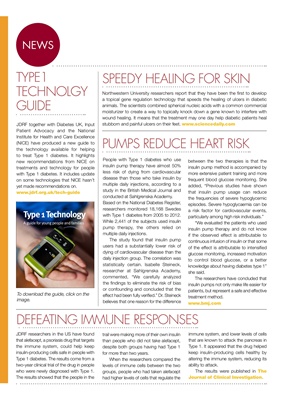
NEWS
TYPE1
TECHNOLGY
GUIDE
JDRF together with Diabetes UK, Input
Patient Advocacy and the National
Institute for Health and Care Excellence
(NICE) have produced a new guide to
the technology available for helping
to treat Type 1 diabetes. It highlights
new recommendations from NICE on
treatments and technology for people
with Type 1 diabetes. It includes update
on some technologies that NICE hasn't
yet made recommendations on.
www.jdrf.org.uk/tech-guide
SPEEDY HEALING FOR SKIN
Northwestern University researchers report that they have been the first to develop
a topical gene regulation technology that speeds the healing of ulcers in diabetic
animals. The scientists combined spherical nucleic acids with a common commercial
moisturizer to create a way to topically knock down a gene known to interfere with
wound healing. It means that the treatment may one day help diabetic patients heal
stubborn and painful ulcers on their feet. www.sciencedaily.com
People with Type 1 diabetes who use
insulin pump therapy have almost 50%
less risk of dying from cardiovascular
disease than those who take insulin by
multiple daily injections, according to a
study in the British Medical Journal and
conducted at Sahlgrenska Academy.
Based on the National Diabetes Register,
researchers monitored 18,168 Swedes
with Type 1 diabetes from 2005 to 2012.
While 2,441 of the subjects used insulin
pump therapy, the others relied on
multiple daily injections.
The study found that insulin pump
users had a substantially lower risk of
dying of cardiovascular disease than the
daily injection group. The correlation was
statistically certain. Isabelle Steineck,
researcher at Sahlgrenska Academy,
commented, "We carefully analyzed
the findings to eliminate the risk of bias
or confounding and concluded that the
effect had been fully verified." Dr. Steineck
believes that one reason for the difference
PUMPS REDUCE HEART RISK
DEFEATING IMMUNE RESPONSES
JDRF researchers in the US have found
that alefacept, a psoriasis drug that targets
the immune system, could help keep
insulin-producing cells safe in people with
Type 1 diabetes. The results come from a
two-year clinical trial of the drug in people
who were newly diagnosed with Type 1.
The results showed that the people in the
Type 1 Technology
A guide for young people and families
between the two therapies is that the
insulin pump method is accompanied by
more extensive patient training and more
frequent blood glucose monitoring. She
added, "Previous studies have shown
that insulin pump usage can reduce
the frequencies of severe hypoglycemic
episodes. Severe hypoglycaemia can be
a risk factor for cardiovascular events,
particularly among high risk individuals."
"We evaluated the patients who used
insulin pump therapy and do not know
if the observed effect is attributable to
continuous infusion of insulin or that some
of the effect is attributable to intensified
glucose monitoring, increased motivation
to control blood glucose, or a better
knowledge about having diabetes type 1"
she said.
The researchers have concluded that
insulin pumps not only make life easier for
patients, but represent a safe and effective
treatment method.
www.bmj.com
trail were making more of their own insulin
than people who did not take alefacept,
despite both groups having had Type 1
for more than two years.
When the researchers compared the
levels of immune cells between the two
groups, people who had taken alefacept
had higher levels of cells that regulate the
immune system, and lower levels of cells
that are known to attack the pancreas in
Type 1. It appeared that the drug helped
keep insulin-producing cells healthy by
altering the immune system, reducing its
ability to attack.
The results were published in The
Journal of Clinical Investigation.
To download the guide, click on the
image.